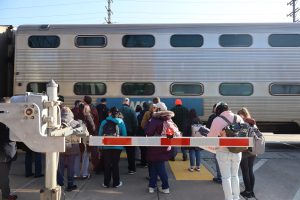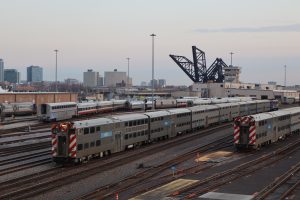Chicago area transit providers plan for service cuts amid funding uncertainty
By Igor Studenkov For Chronicle Media — June 12, 2025
Metra riders in downtown Downers Grove wait for the BNSF Line train to leave the station. (Photos by Igor Studenkov/For Chronicle Media)
After the bill that would have bailed out Chicago area transit agencies failed to clear both chambers of the Illinois General Assembly, CTA, Metra, Pace and RTA were left with no choice but to start planning for cuts.
All four agencies are facing a fiscal cliff as fare revenues continue to lag behind pre-pandemic numbers and federal stimulus funds run out next year.
As Chronicle Media previously reported, this year’s session saw two bills to address the issue — one that would have consolidated the four agencies into one and a bill that would strengthen the RTA and give labor unions seats on the agency boards. During the final week of the General Assembly’s regular session, legislators in both chambers introduced another proposal. The key difference was that only the Senate version had revenue sources.
Both bills were amended several times, and the proposal to raise tolls to help pay for transit were dropped. However, other ideas — most notably, a new rideshare fee, fee on deliveries and the proposal to let transit agencies keep the portion of the RTA tax that is sent to the collar counties — attracted controversy. The Senate bill cleared the Illinois Senate, but didn’t clear the Illinois House before the regular session ended May 31.

Metra trains at the Chicago Rail Yard
Legislators can still pass the funding fix during the fall veto session or a special session, but they will face a higher supermajority threshold to pass anything. In the meantime, transit agencies are legally required to begin developing next year’s budgets based on the money they know is coming in — which means that, unless and until there is new funding, they must assume they collectively face a $771 million budget shortfall. The budgets must be finalized by the end of November.
State Sen. Ram Villivalam, D-Chicago, who chairs his chamber’s Transportation Committee, previously indicated to the media that legislators were looking to generate enough revenue to give transit around $1.5 billion — a figure recommended by Chicago Metropolitan Agency for Planning to allow CTA, Metra and Pace to invest in more frequent service and make other improvements.
The version of the transit bill the Illinois Senate passed would’ve created a rideshare trip fee equal to 10 percent of the fare, a $1.50 “climate impact fee” on all deliveries except “groceries and prescription and nonprescription drugs and medications” to help pay for transit.
The fee earned backlash from chambers of commerce and faith leaders. A letter co-signed by the Illinois Hispanic Chamber of Commerce, Little Village Chamber of Commerce, National Latino Education Institute and Spread Love community arts and events organization argued that the tax would disproportionately impact low-income customers, since the tax would have been the same regardless of price and value of the ordered item.
“At the same time, small local businesses would face declining orders, and the workers who make these deliveries would see reduced income from fewer opportunities to earn,” the letter continued. “At a time when many families are already having difficult conversations at the kitchen table about how to make ends meet, this would only increase uncertainty for hardworking people across Illinois. The state should be seeking ways to ease burdens on working families — not add new ones.”
The bill would have also created a suburb-wide real estate transfer tax at the rate of $1.50 for every $500 paid. Chicago had its own real estate transfer tax since 2008, and it’s used to fund CTA.
Different expenditures
In Cook County, half of that revenue from the new tax would have gone to cover CTA’s pension obligations. The tax collected in collar continues would have gone entirely to transit.
The bill would have also established a state-wide 3 cents-per-kilowatt hour fee for charging electric cars. Unlike other fees, it would have been used to fund transit agencies throughout the state, not just in the Chicago area.
But what caused the most controversy in the collar counties was the proposed shift in how the portion of the sales tax that goes to the RTA is allocated. Collar counties currently get one-fourth of the RTA sales tax collected within their borders back to help pay for public safety and transportation needs. For example, McHenry County plans to use its RTA sales tax revenue to help pay for its share of the costs of building a new Metra train yard in Woodstock.
The bill would have allowed RTA to keep that revenue.
In May 29, Lake County sent out a press release decrying the proposal. It indicated that, over the next five years, it plans to use the RTA sales tax revenue to help fund around 100 road projects, Ride Lake County county-wide on-demand bus service for seniors and riders with disabilities and buy snowplows and other road maintenance equipment for Lake County Division of Transportation.
Lake County Board chair Sandy Hart said that it would be “impossible” to cover the revenue loss from other sources.
“If enacted, this bill would slash over 50 percent of the revenue that funds Lake County’s transportation program,” she stated. “For the next five years, this would lead to the elimination of 132 planned projects, undermining critical infrastructure improvements and ending services like paratransit for seniors and people with disabilities.”
Potential cuts
In late March, CTA, Metra and Pace went before the RTA Board of Directors to present the general outlines of their plans if the funding doesn’t come through.
In a memo to the RTA board, the CTA indicated that it may “need to eliminate service on all or a portion of four of its eight rail lines and close or severely diminish service to over 50 rail stations,” which would represent about a third of all ‘L’ stations. Train frequencies would be reduced by a quarter. CTA acting president Nora Leerhsen also shared a map of 74 out of 127 CTA bus routes that could be cut, and while no part of Chicago and the neighboring suburbs would be entirely spared, it would hit suburbs like Oak Park and South Side neighborhoods particularly hard.
Metra would suspend service on the Metra Electric Line’s Blue Island branch. SouthWest Service and North Central Service lines would become rush hour only, and the service frequency on the rest of the lines would be reduced to an average of once an hour on weekdays and once every two hours on weekends, and evening service would end earlier. Some rush-hour express trains would remain. West suburban BNSF Line, Union Pacific Northwest Line, Union Pacific North line and remaining sections of the Metra Electric line would be hit especially hard.
Pace isn’t planning to cut any routes, but it would suspend all weekend service and evening service after 8 p.m. Service frequencies on the busier routes would drop to 30-60 minutes, and two Pulse express bus routes in Northwest suburbs would drop from an average of once every 15 minutes to once every half an hour. The cuts would hit Cook County and major suburban cities such as Elgin, Aurora and Naperville particularly hard.
The cuts would also have the side-effect of reducing paratransit service, which Pace provides in Chicago and the suburbs. Under federal law, it is required to provide the service within three-fourths of a mile of any fixed bus route or a rail station.
According to the timeline shared at the RTA board meeting, planning for cuts, including the federally required Title VI analysis, will begin this month. The proposed cuts are expected to be finalized in September to October, which is also when the transit agencies would send out initial layoff notices. RTA will sign off on how much funding is available in September, and the transit agencies will release the proposed budgets by October.






